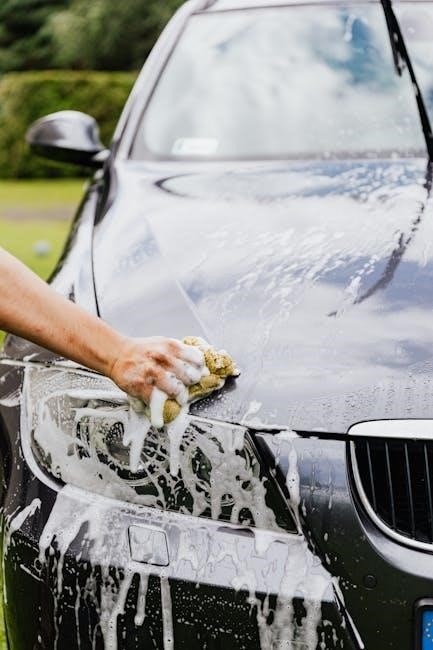Safety Precautions
Always read the user manual before using your Asko dishwasher. Ensure proper electrical grounding and avoid overloading. Keep children away and follow eco-friendly guidelines for safe operation.
1.1 General Safety Tips
Always read the user manual before operating your Asko dishwasher. Ensure the appliance is properly installed and electrically grounded to avoid hazards. Keep children away from the dishwasher door and baskets, as they may trip or get injured. Never overload the dishwasher, as this can cause imbalance and damage. Regularly inspect the power cord and plug for wear or damage. Avoid using abrasive cleaners that might harm the dishwasher’s surfaces. Follow eco-friendly guidelines for water and energy conservation. Do not leave the dishwasher door open, as it may pose a tripping hazard. Ensure all users understand basic safety precautions to maintain optimal performance and safety.
1.2 Child Safety Features
Your Asko dishwasher is equipped with child safety features to ensure safe operation. The child lock prevents accidental start or changes during a cycle, while secure latches keep the door closed. Always supervise children near the dishwasher and teach them to avoid touching hot surfaces or utensils. Regularly check that all safety features are functioning properly. Ensure the dishwasher is installed in a stable position to prevent tipping. By following these guidelines, you can create a safer environment for children while maintaining the appliance’s efficiency and performance. These features are designed to provide peace of mind for families with young children, ensuring safe and reliable use of the dishwasher.

Installation and Setup
Proper installation ensures optimal performance. Follow the instructions for electrical grounding and water connections. Use the provided setup guide to configure settings and initiate the first wash cycle.
2.1 Physical Installation Steps
Start by ensuring the dishwasher is placed on a level surface. Follow the installation guide for proper electrical and water connections. Secure the appliance to prevent movement during operation. Measure the space accurately to ensure a perfect fit. Use the provided mounting hardware to stabilize the unit. Connect water supply lines securely to avoid leaks. Ensure the drain hose is properly routed and vented. Double-check all connections before powering on. Refer to the user manual for specific instructions tailored to your Asko model. Proper installation ensures safe and efficient operation, minimizing the risk of damage or malfunction over time.
2.2 Initial Setup and Configuration
After installation, refer to the user manual for initial setup instructions. Program the dishwasher by selecting your preferred language and setting the clock. Check the water hardness level and adjust the detergent dispenser accordingly. Familiarize yourself with the control panel and cycle options. Ensure all settings are configured before running the first cycle. Some models may require software updates or specific calibration steps. Always follow the manufacturer’s guidelines for proper configuration. This ensures optimal performance and prevents potential issues. Consult the manual for model-specific instructions, as settings may vary. Proper setup maximizes efficiency and longevity of your Asko dishwasher.

Loading the Dishwasher
Load dishes facing the center, ensuring proper water flow. Place utensils in designated holders and avoid overloading. Separate delicate items from heavy dishes for optimal cleaning and safety.
3.1 Best Practices for Loading Dishes
For optimal cleaning, load dishes facing the center to ensure water flow. Place utensils in designated holders and avoid overloading. Separate delicate items from heavy dishes to prevent damage. Check for large items blocking spray arms and ensure taller dishes are at the back. Use the upper rack for cups, glasses, and smaller bowls, while reserving the lower rack for plates and larger items. Secure fragile items in protective slots to avoid breakage. Avoid nesting dishes tightly, as this can hinder water circulation. Always face dirty surfaces toward the center for thorough cleaning. Proper loading ensures efficient washing and protects your dishes from damage.
3.2 Common Loading Mistakes to Avoid
Avoid overloading the dishwasher, as this can block water and detergent flow, leading to poor cleaning results. Never nest dishes too tightly, as this prevents water from reaching all surfaces. Do not place large or heavy items in a way that blocks the spray arms, as this reduces efficiency. Avoid placing fragile items near heavy dishes to prevent breakage. Do not ignore the dishwasher’s layout; failing to face dirty surfaces toward the center can leave dishes unclean. Overcrowding utensil holders can also hinder proper cleaning. Regularly check for these mistakes to ensure optimal performance and protect your dishes from damage.

Wash Cycles and Options
Standard cycles include Heavy Duty, Normal, and Eco modes. Advanced options feature silent operation, steam cleaning, and customizable temperature settings for optimal results and energy efficiency.
4.1 Standard Wash Cycles
Standard wash cycles on Asko dishwashers include Heavy Duty, Normal, and Eco modes. Heavy Duty tackles heavily soiled dishes, while Normal is ideal for everyday use. Eco mode uses less water and energy, perfect for lighter loads. These cycles ensure efficient cleaning while maintaining energy efficiency. Proper use of these cycles contributes to optimal performance and sustainability. Always refer to the user manual for cycle recommendations based on load size and soil level to achieve the best results.
4.2 Advanced Wash Options
Advanced wash options on Asko dishwashers enhance cleaning efficiency and customization. Features like Intense Wash target heavily soiled items, while Gentle Care protects delicate dishes. Delay Start allows scheduling wash cycles, and Steam Cleaning improves hygiene. These options optimize performance for specific needs, ensuring dishes are spotless and appliances run efficiently. Refer to the user manual for details on activating and combining these settings for tailored results.

Maintenance and Cleaning
Regularly clean filters and check for blockages to ensure optimal performance. Run cleaning cycles and wipe down surfaces to maintain hygiene and prevent grease buildup.
5.1 Regular Maintenance Tasks
Regular maintenance is crucial for optimal performance of your Asko dishwasher. Start by cleaning the filters after each use to remove food particles and debris. Check the drain hose for blockages and ensure it is securely connected. Wipe down the door seals and interior to prevent mold and mildew buildup. Run a cleaning cycle every month using a dishwasher cleaner to remove grease and odors. Additionally, check and top up the rinse aid levels as instructed in the user manual. Regularly inspect the spray arms for clogs and clean them if necessary. These tasks will ensure your dishwasher runs efficiently and effectively, maintaining hygiene and performance over time.
5.2 Deep Cleaning the Dishwasher
For a deep clean, run a hot water cycle with a dishwasher cleaner or white vinegar in the rinse aid dispenser. Add baking soda to the drum and run an additional cycle to eliminate odors. Manually clean the door seals and spray arms with a soft brush and mild detergent. Check the drain filter and remove any debris. Repeat this process every few months to maintain hygiene and efficiency. This comprehensive cleaning ensures optimal performance and prevents grease buildup, keeping your Asko dishwasher in excellent condition.

Troubleshooting Common Issues
Check error codes in the user manual for specific solutions. Ensure proper installation and regular maintenance. Clean filters and spray arms for optimal performance and to resolve common issues.
6.1 Identifying Error Codes
Refer to the user manual for a list of error codes specific to your Asko dishwasher model. Codes like E1 or E2 indicate issues such as water supply problems or drainage malfunctions. Always consult the manual for precise explanations and solutions. If an error code appears, ensure the dishwasher is properly installed and maintained. Restarting the appliance or checking connections often resolves minor issues. For persistent problems, contact Asko customer support for professional assistance. Regular maintenance, such as cleaning filters, can prevent many error codes from occurring. Understanding these codes helps troubleshoot effectively, ensuring optimal performance and longevity of your dishwasher.
6.2 DIY Repair Tips
For minor issues, consult the user manual for DIY repair guidance. Check and clean filters regularly to ensure proper water flow. If the dishwasher doesn’t drain, inspect the drain hose for blockages. Reset the appliance by turning it off and on again to resolve temporary glitches. Address error codes by following the manual’s troubleshooting section. Ensure the dishwasher is level to prevent vibrations. Avoid using harsh chemicals for cleaning, as they may damage components. For persistent problems, contact Asko customer support. Regular maintenance, such as cleaning filters and checking connections, can prevent many issues. DIY repairs can save time and money but always prioritize safety and manufacturer recommendations.
Eco Mode and Energy Efficiency
Eco Mode optimizes energy and water usage for eco-friendly operation. It extends cycle times at lower temperatures, reducing energy consumption while maintaining cleaning performance. Use it for lightly soiled dishes to maximize efficiency and minimize environmental impact.
7.1 How Eco Mode Works
Eco Mode on your Asko dishwasher is designed to optimize energy and water usage. It achieves this by extending cycle times and using lower temperatures, ensuring dishes are cleaned thoroughly while reducing energy consumption. This mode is ideal for lightly soiled dishes and helps minimize environmental impact. By adjusting water heating and wash intensity, Eco Mode balances cleaning performance with eco-friendly operation. It is a practical choice for everyday use, promoting sustainability without compromising results. This feature is a key part of Asko’s commitment to energy efficiency and environmentally responsible appliance design.
7.2 Tips for Maximizing Energy Efficiency
To maximize energy efficiency with your Asko dishwasher, always run full loads to avoid wasting resources. Use the Eco Mode for lightly soiled dishes, as it reduces water and energy consumption. Ensure dishes are scraped clean before loading to minimize pre-rinse cycles. Regularly clean the dishwasher’s filters and check for blockages to maintain optimal performance. Avoid using excessive detergent, as this can lead to re-washes and higher energy use. Additionally, explore energy-saving cycles and adjust settings based on soil levels. Proper maintenance, such as checking door seals and hoses, ensures efficient operation. By following these tips, you can lower energy usage while maintaining cleaning effectiveness.

Accessing User Manuals and Guides
Visit the official ASKO website to search for your dishwasher’s user manual by product code or model name, ensuring you find the correct guide for optimal use.
8.1 How to Find Your User Manual
To locate your ASKO dishwasher user manual, visit the official ASKO website and use the search function. Enter your product code or model name, such as “OT8664S” or “739857,” to find the specific guide for your appliance. The manual is available for download in PDF format, ensuring easy access to detailed instructions, safety information, and troubleshooting tips. Additionally, you can refer to the customer care section for further assistance. Always ensure you have the correct manual for your model to guarantee accurate information and optimal performance of your dishwasher.
8.2 Model-Specific Guides
Model-specific guides for ASKO dishwashers provide tailored instructions for your particular appliance. These guides are available on the ASKO website and can be accessed by entering your dishwasher’s model number, such as “D3251” or “D5524XXLFI.” Each guide includes detailed information about features, operation, and maintenance specific to your model. They also offer troubleshooting tips and eco-mode instructions, ensuring you get the most out of your dishwasher. Regularly refer to your model-specific guide to maintain optimal performance and address any issues quickly. This resource is essential for understanding your dishwasher’s unique capabilities and ensuring safe, efficient operation.

Additional Tips for Optimal Performance
For optimal performance, regularly clean filters, check detergent dosage, and ensure proper loading. Refer to your model-specific guide for eco-mode and noise reduction tips.
9.1 Tips for Detergent Usage
Use the recommended detergent dosage to avoid residue buildup. Choose eco-friendly detergents for energy efficiency. Regularly clean the detergent dispenser for optimal performance. Avoid overloading, as this can reduce cleaning effectiveness. Ensure water hardness settings match your area to prevent scaling. Always use rinse aid to improve drying results. Store detergent in a dry place to maintain potency. For specific guidelines, refer to your model’s user manual, as detergent requirements may vary. Proper detergent usage enhances cleaning efficiency and prolongs appliance lifespan. Adjust settings in eco-mode for reduced consumption. Regularly check and clean filters to ensure optimal detergent distribution during cycles. Follow these tips for better results and appliance longevity.
9.2 How to Reduce Noise
To minimize noise, ensure your Asko dishwasher is installed on a level surface and secured firmly; Check for loose items that may rattle during cycles. Properly loading dishes, avoiding overcrowding, and using silent wash cycles can reduce operational noise. Regularly clean filters and drains to prevent blockages that may cause vibrations. Ensure the dishwasher is balanced to avoid resonance. Use eco-mode for quieter operation during off-peak hours. Keep the dishwasher maintained, as worn parts can increase noise. Avoid placing heavy items in the utensil basket, as they may vibrate. For models with noise-reduction features, enable them for quieter performance. Regular maintenance ensures optimal noise levels and longevity of your appliance.






























































